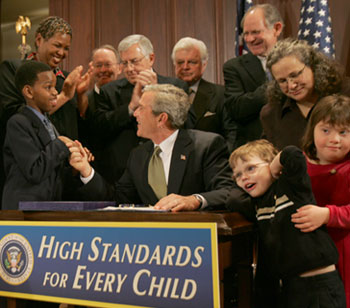Transition Services
When your child has an Individualized Education Program (IEP), he has a support structure within the school. He likely has speech therapy sessions with the school speech-language pathologist (SLP), he may have a one-on-one aide in the classroom, and he may have other accommodations as well. But what happens when he leaves school? As your child grows into a young adult and nears graduation age, you may start to worry about how he’ll handle the outside world with a speech disorder. The Individuals with Disabilities Education Act (IDEA) provides for transition services, which are intended to facilitate independent living and post-secondary education, if applicable.
Transition Services Defined
When IDEA was reauthorized in 2004 by President George Bush, the definition of transition services was revamped. Here is part of the new definition, taken from the U.S. Department of Education website:
(It) is designed to be within a results-oriented process, that is focused on improving the academic and functional achievement of the child with a disability to facilitate the child’s movement from school to post-school activities, including postsecondary education, vocational education, integrated employment (including supported employment); continuing and adult education, adult services, independent living, or community participation.
The regulations go on to state that transition services must be individualized, based on many factors, and include instruction, community experiences, daily living skills (if needed), and the development of post-school objectives.
What This Means For Your Child
According to the law, your child’s IEP team must include transition services in his IEP by the time he turns 16. When developing the IEP goals for transition services, your child’s strengths, weaknesses, interests, and preferences must be taken into account.
Even if your child’s speech disorder is mild, transition services can still benefit him. For example, services might include career counseling and resume writing skills. If he struggles with social interactions, transition services should include strategies for improving interpersonal communication, particularly in the workplace. In some cases, transition services might include an internship to obtain work skills.
Planning Process
While transition services must be in effect when your child turns 16 years old, planning may begin earlier. It is essential for your child to take an active role in planning transition services. He should discuss his hopes and goals for the future, possible career plans, and whether he wishes to pursue a post-secondary education. Your child should actively attend IEP transition meetings (expect a whole bunch of them). This not only allows his preferences to be heard, it will teach your child valuable self-advocacy skills.
While every school district is different, in general, expect to work with the same professionals on your IEP transition team as you did for previous IEP meetings. The school district is also required to have a representative on hand who can explain the availability of public resources. The IEP transition team will consider the accommodations and services that your child requires to successfully establish a career or to complete a post-secondary education (which might include vocational education). Specific, measurable goals will be written and the exact services your child will receive must be spelled out.





